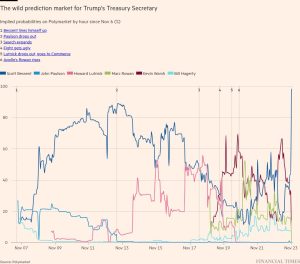A ‘full fat’ Budget is impossible — what are the trade-offs?
Unlock the Editor’s Digest for free
Roula Khalaf, Editor of the FT, selects her favourite stories in this weekly newsletter.
In July’s election, voters demanded a prudent government that would borrow responsibly, fix public services, grow the economy and keep tax rises to a minimum. Labour promised the lot. In government, it now has to confront the public with the trade-offs that come with power.
From all of the soundings and analysis that are emerging, the chancellor Rachel Reeves is set to announce a traditional Labour tax, spend and borrow Budget on October 30. Her direction of travel appears to be “full fat” Labour in terms of public investment and tax increases, with a semi-skimmed approach to additional borrowing and a meagre diet of skimmed milk for day-to-day public spending.
To understand why, we need to look at the period since the election. Incoming ministers — and outside experts — were genuinely shocked by the public spending legacy of the Conservatives. The party had brushed all problems, including expensive asylum and public sector pay pressures, under a giant Treasury carpet labelled “no longer our problem”. This was hidden even from the independent fiscal watchdog, the Office for Budget Responsibility. The left will describe the next moves as fixing this inheritance, the right will say it’s Labour profligacy, but the result is the same: the trade offs are more difficult than either admitted during the election.
Clearly, Reeves has decided to free herself from the letter, but not the spirit, of the existing public debt fiscal rule. The current rule, to see “net public debt excluding the bank of England” falling as a share of GDP after five years, will not survive but other measures of public liabilities, which are arguably better, will still be set to come down. This will allow Reeves to plan public sector net investment at levels similar to this year’s 2.4 per cent of GDP rather than watching it fall to 1.7 per cent as planned by the previous government.
This is a significant amount. It’s not as much as some rather implausibly think it should be but it would far exceed the previous Labour government’s average of 1.5 per cent of GDP between 1997 and 2010. It is also above the close to 2 per cent invested by the Conservatives. So the government needs to show that the money from this “full fat” Labour choice will be well spent.
The consequence of redefining the debt target is that borrowing will be higher than the previous government’s pencilled-in plans and the debt rule no longer becomes the binding fiscal constraint. It will be replaced by the “golden rule”: a version of that first introduced by Gordon Brown in 1998, demanding that tax revenues meet day-to-day public spending needs. The target to achieve this current balance is likely to be set for the end of this parliament in 2029-30. This should be a fixed date rather than a rolling target that government never need comply with.
The current budget rule significantly constrains borrowing, keeping it to roughly the level of investment. This will stabilise most measures of public debt and provide significant reassurance to markets. Although borrowing will rise, it will be directed towards productive investment — there is no need for another Liz Truss moment. With the Conservative government expecting to meet the current rule only in 2028-29, this “semi-skimmed” approach is likely to delay that by one year.
A strictly limited increase in the current budget deficit implies that any rise in day-to-day public spending will require tax increases. When officials talk about a gap of roughly £40bn they need to close, it is roughly the difference between projected current public expenditure in 2029-30 and what is likely to be raised by the tax system, building in sufficient headroom so that the government does not have to revisit taxes and spending every year. It takes into account Labour’s manifesto commitments and a desire not to cut any departmental budgets as a share of national income.
This is a realistic spending settlement — better than Conservative plans dubbed worse than a “work of fiction” by the OBR. But it is not generous. It is provoking ministerial complaints already and would increase real current public spending by roughly half the rate of Tony Blair’s governments in the 2000s, when public services are in a worse state and pressures from an ageing population higher. This “skimmed” Labour is unlikely to make many on the left happy. To fix public services, ministers will need to wrestle with feeble productivity growth, especially in health.
Although the spending is limited, the necessary tax rises are large. Some were already in Labour’s manifesto, such as VAT on private school fees and additional levies on non-doms. Reeves might catch a bit of luck from last-minute forecasts but do not expect too much. Growth gains from additional public spending are small and offset by damage from the new, large tax increases planned.
Raising employer national insurance contributions, either by boosting the main 13.8 per cent rate, levying NICs on pension contributions, or both, looks likely to fill the lion’s share of the shortfall. It’s not great to hike a tax that, while formally paid by employers, ultimately gets shifted to workers and jobs. But it is the best option available for a government that wants to fix public services. And this measure is very much “full fat” Labour: the likely tax rise is at least twice as large in real terms as that of Brown’s first Budget in 1997.
Reeves’s constraints are unavoidable. She cannot spend more, borrow less and keep taxes where they are. This was apparent at the election. Her choice to invest, tax, borrow and spend day-to-day is a reasonable way to address the trade offs. She might have said this earlier. But now is not the time to cry over spilled milk.
#full #fat #Budget #impossible #tradeoffs




